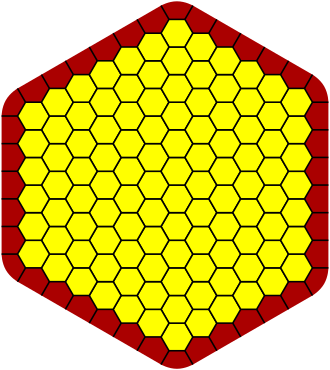
Gomoku, also called Five in a Row, is an abstract strategy board game. It is traditionally played with Go pieces on a 15×15 Go board while in the past a 19×19 board was standard. Because pieces are typically not moved or removed from the board, gomoku may also be played as a paper-and-pencil game. The game is known in several countries under different names.
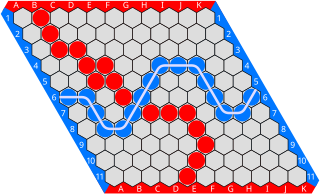
Hex is a two player abstract strategy board game in which players attempt to connect opposite sides of a rhombus-shaped board made of hexagonal cells. Hex was invented by mathematician and poet Piet Hein in 1942 and later rediscovered and popularized by John Nash.

The game of Go has simple rules that can be learned very quickly but, as with chess and similar board games, complex strategies may be employed by experienced players.

Go is an abstract strategy board game for two players in which the aim is to surround more territory than the opponent. The game was invented in China more than 4,500 years ago and is believed to be the oldest board game continuously played to the present day. A 2016 survey by the International Go Federation's 75 member nations found that there are over 46 million people worldwide who know how to play Go, and over 20 million current players, the majority of whom live in East Asia.

The rules of Go have seen some variation over time and from place to place. This article discusses those sets of rules broadly similar to the ones currently in use in East Asia. Even among these, there is a degree of variation.

Havannah is a two-player abstract strategy board game invented by Christian Freeling. It belongs to the family of games commonly called connection games; its relatives include Hex and TwixT. Havannah has "a sophisticated and varied strategy" and is best played on a base-10 hexagonal board, 10 hex cells to a side.
The pie rule, sometimes referred to as the swap rule, is a rule used to balance abstract strategy games where a first-move advantage has been demonstrated. After the first move is made in a game that uses the pie rule, the second player must select one of two options:
- Letting the move stand. The second player remains the second player and moves immediately.
- Switching places. The second player becomes the first-moving player with the move already done by the opponent, and the opponent plays the first move of their new color.
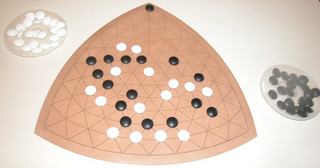
Y is an abstract strategy board game, first described by John Milnor in the early 1950s. The game was independently invented in 1953 by Craige Schensted and Charles Titus. It is a member of the connection game family inhabited by Hex, Havannah, TwixT, and others; it is also an early member in a long line of games Schensted has developed, each game more complex but also more generalized.
Gonnect is a strategy board game for two players invented by João Pedro Neto in 2000. The game is played with standard Go equipment and basically uses the same rules as Go, however the goal of the game is to construct a group that connects any two opposite sides.
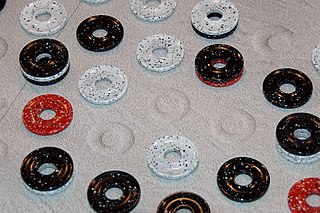
DVONN is a two-player strategy board game in which the objective is to accumulate pieces in stacks. It was released in 2001 by Kris Burm as the fourth game in the GIPF Project. DVONN won the 2002 International Gamers Award and the Games magazine Game of the Year Award in 2003.
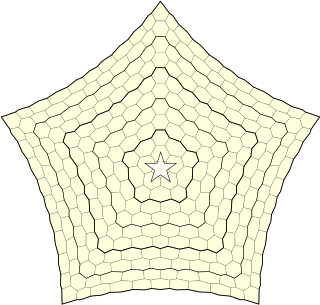
*Star is a complex abstract strategy game by Ea Ea, a designer of Y. It is a redevelopment of his earlier game Star.
The Black Path Game is a two-player board game described and analysed in Winning Ways for your Mathematical Plays. It was invented by Larry Black in 1960.

A hex map, hex board, or hex grid is a game board design commonly used in wargames of all scales. The map is subdivided into a hexagonal tiling, small regular hexagons of identical size.

Hexic is a 2003 tile-matching puzzle video game developed by Carbonated Games for various platforms. In Hexic, the player tries to rotate hexagonal tiles to create certain patterns. The game is available on Windows, Xbox 360, Windows Phone and the web. Many clones are available for Android and iOS. The game was designed by Alexey Pajitnov, best known as the creator of Tetris. While most earlier releases of the game were developed by Carbonated Games, the most recent version released for Windows and Windows Phone is developed by Other Ocean. The name is a portmanteau of the words "hectic" and "hexagon".

Hexagonal chess is a group of chess variants played on boards composed of hexagon cells. The best known is Gliński's variant, played on a symmetric 91-cell hexagonal board.

There are many variations of the simple rules of Go. Some are ancient digressions, while other are modern deviations. They are often side events at tournaments, for example, the U.S. Go Congress holds a "Crazy Go" event every year.
A connection game is a type of abstract strategy game in which players attempt to complete a specific type of connection with their pieces. This could involve forming a path between two or more endpoints, completing a closed loop, or connecting all of one's pieces so they are adjacent to each other. Connection games typically have simple rules, but complex strategies. They have minimal components and may be played as board games, computer games, or even paper-and-pencil games.
Craige Schensted, who formally changed his name to Ea Ea, was an American physicist and mathematician who first formulated the insertion algorithm that defines the Robinson–Schensted correspondence. Under a different form, that correspondence had earlier been described by Gilbert de Beauregard Robinson in 1938, but it is due to the Schensted insertion algorithm that the correspondence has become widely known in combinatorics. Schensted also designed several board games including *Star, Star, and Y. In 1995, he changed his name to Ea, the Babylonian name for the Sumerian god Enki, and in 1999 changed it to Ea Ea. He lived on Peaks Island in Portland, Maine.

Onyx is a two-player abstract strategy board game invented by Larry Back in 1995. The game features a rule for performing captures, making Onyx unique among connection games.
This glossary of board games explains commonly used terms in board games, in alphabetical order. For a list of board games, see List of board games; for terms specific to chess, see Glossary of chess; for terms specific to chess problems, see Glossary of chess problems.
